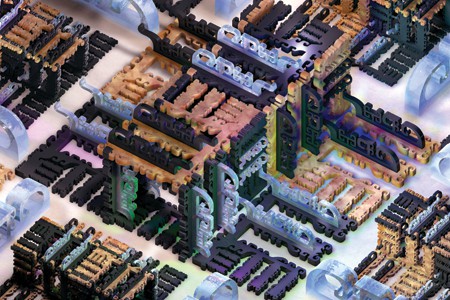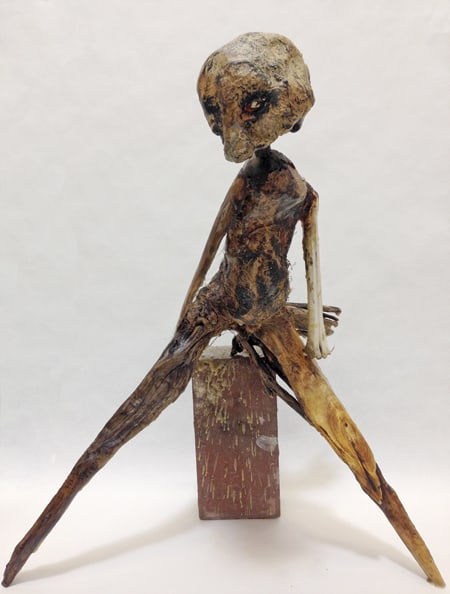The Road to Hebron
2014
Amjad Faur
Carbon pigment print
39 1⁄2″ x 32 1⁄2″
Photo: courtesy PDX Contemporary Art
As valuable as Photoshop and other digital manipulation programs have become to the arts, craft, and commerce, they have nonetheless so muddied the dwindling boundaries between verité and fiction as to make old-fashioned camera tricks appear downright Jurassic. And because Photoshop and CGI effects have become so old-hat from Chelsea to Madison Avenue to Hollywood, a counter-movement has arisen among artists who steadfastly refuse to toy with their imagery in post-production. Amjad Faur is one such artist. Based in Olympia, Washington, where he teaches art at Evergreen State College, Faur stages elaborate tableaux in his studio, deploying all the tools of theatrical stagecraft to create the setting for a single photographic exposure. Using a large-format camera, he captures images that sometimes appear to violate the laws of physics, evoking Philippe Halsman’s fantastically staged but photographically unmanipulated Dali Atomicus. This illusionism is seldom for the sake of virtuosity alone. Faur is of Irish-American and Palestinian heritage, and his vignettes incorporate sometimes subtle, sometimes not-so-subtle, references to the sociopolitical trials that have shaped the destinies of the British Isles and the Middle East. “Amjad Faur: Sun Kings” runs at PDX Contemporary Art, from November 4 – 29.
Tower of the Americas
2014
Jessica Mallios
Video still, HD video
Photo: courtesy of Disjecta and the artist
On the heels of curator-in-residence Rachel Adams’ witty and space-activating “Intimate Horizons” at Disjecta, Adams follows up with another out-of-the-box exhibition, entitled “Sightings.” The show includes two video installations: Skyward (2012) by Los Angeles-based artist Kevin Cooley; and Tower of the Americas (2014) by Austin, Texas-based Jessica Mallios. Both works hail from the lineage of film-based “endurance art,” epitomized by Andy Warhol’s 1964 marathon, Empire. Like that film, Cooley’s and Mallios’ offerings are more about ambient experience and locale than any notion of plot or character. In Cooley’s work, a car-mounted camera gazes straight up at the Southern California sky, capturing not only endless expanses of hazy azure, but also a procession of palm trees overhead, bridges, and a blimp. In the film’s most striking section, the car drives underneath an airplane, following it with uncanny precision; when the car goes through a long tunnel, the airplane is still right overhead when the car emerges on the other side. Car culture has, of course, always been part of SoCo’s lore, and if Cooley’s film inspires a kind of dèjà vu, it also reminds us that looking heavenward in this floatiest of American oases is not just a tradition, but a bona fide cultural trope. Mallios’ Tower of the Americas also considers a shifting vista from a static position, but in this case, the camera is static while the view changes out the window of the rotating San Antonio building after which the film is titled. At times, the camera shifts focus from the outside vista to the glass of the window itself, with its scratches, smudges, and the occasional insect. The film takes in the tower’s full, 61-minute rotation, making for a viewing experience that is more mesmerizing than riveting. “Sightings” will be on view at Disjecta from November 21 – January 4, 2015.
The Seamstress Amassed Her Magnificent Collection of Threads, Long Past Their Expiration Date
2014
Cassandra Straubing
Cast glass, spools of thread
23″ x 201⁄2″ x 3″
Photo: E. Torrance courtesy Bullseye Gallery
For many artists working with cast glass, the challenge of depicting fabric has proven irresistible. To transliterate the softness and suppleness of textile into an unyielding medium is a devilish technical challenge, but it has also proven fertile thematic ground for artists such as Karen LaMonte and Silvia Levenson, both of whom have worked with dress forms as vehicles through which to critique gender roles. In “Poetic Ghost,” Cassandra Straubing takes up the blouse form as a central conceit. The artist, based in San Jose, California, is intrigued by the history of the blouse, in particular its supplanting of the dress as garment-of-choice for women integrating into the business work force in the early 20th century. Straubing is concerned not only with this garment as a symbol of women’s professional empowerment, but also its impact on generations of immigrants who worked in the “shirtwaist” factories of New York City and Philadelphia. Adapting the creations of Bay Area fashion designer Babette, Straubing casts blouse forms in glass, producing objects that reference changing notions of femininity in the business and social arenas. It’s both fitting and ironic that the unseen barrier to women’s workplace equality is known as the “glass ceiling.” In Straubing’s practice, glass has a hand in shattering that ceiling, or at the very least, throwing it into crystalline relief. Cassandra Straubing: “Poetic Ghost” runs from November 5 – December 23 at Bullseye Gallery.
There Are No Eyes Here
2014
Samantha Wall
Conté crayon, charcoal, and graphite
41″ x 30″
Photo: Dan Kvitka, courtesy Laura Russo Gallery
One of the most fascinating things about Samantha Wall’s drawings on paper is the way they merge conceptual aims with virtuosic technique. A Korean-American, Wall has long been concerned with issues of multi-racialism, gender, and feminism. In a memorable recent exhibition at Marylhurst University’s “Art Gym,” and in other work that has placed her among the semi-finalists for Portland Art Museum’s upcoming Contemporary Northwest Art Awards 2015, Wall has considered these overarching topics through the prism of an extraordinary realist technique. The artworks in “indivisible”-all graphite, charcoal, and ink drawings on 48-by-36-inch paper-are loosely based on photographs Wall has taken of, and interviews she has conducted with, multiracial women. Notably, she treats the figures essentially as silhouettes, but with a catch: In some images, the model appears to be pressing against a pane of glass, such that her lips, for example, seem to be smooshed up against the picture plane, like a person kissing a window or a glass shower enclosure. In another image, Wall deliberately undermines the rendering’s realism by handling the subject’s eyes like cartoons. These small touches lend an element of grotesquerie to immaculate drawings that might otherwise come across as “too beautiful.” “Samantha Wall: indivisible” can be seen at Laura Russo Gallery, December 4 – 24.
Domain Terrace Extendr
2014
Brenna Murphy
digital image
Photo: courtesy Upfor Gallery
Directly following her autumn 2014 show, “skyface~TerraceDomain,” at American Medium (Brooklyn, New York), Brenna Murphy installs a new exhibition at UPFOR, where she has shown before to enthusiastic review
s. The new outing will feature prints, sculpture, and an installation, all cohering around her ongoing preoccupation with the intersection of physical reality and cyber-reality. One of Murphy’s signature motifs is the 3D-printed totem. Using 3D printers, themselves seemingly lifted from the pages of science fiction, Murphy turns computer drawings into real-world objects. She then arranges the objects into configurations that often resemble tiki paraphernalia. It’s worth noting that, far from relegating high technology to the realm of geekdom, this artist views software programs as “contemporary folk-art tools,” ergo the tribal feel of many of her sculptural motifs. Moving mechanical parts, garish lighting, computer-modulated noises, and interactive elements complement these immersive, funhouse environments. At the conclusion of her exhibition, Murphy will join her collaborator, Birch Cooper, for a new installation under the duo’s joint moniker, MSHR. (Portland audiences will recall MSHR’s 2013 exhibition at UPFOR, “Liquid Hand.”) At press time, Murphy was in the planning stages of a performance piece, with which she intends to round out this multifarious month-and-a-half-long exhibition. Brenna Murphy’s new work can be seen at UPFOR Gallery, from December 4 – January 17, 2015.
Sittin’ tight
2014
Kris Hargis
Wood, clay, raw clay, adobe clay, hemp fibers, deer bone,
colored pencil, beeswax, damar crystals, and brick
20″x 17 1⁄2″ x 9″
Photo: courtesy Froelick Gallery
In a culture alarmingly obsessed with selfies, Kris Hargis is committed to a considerably longer-standing mode of self-depiction: the painterly self-portrait. Hargis often turns his restless vision and gifted hand to his own visage-and not in any apparent impulse toward self-aggrandizement, for the resulting images are harrowing. Gaunt and spindly, his figure reads as ravaged, his face self-aware, self-critical, melancholic, and existential, even when he dons a whimsical cowboy get-up, as he does in one of the mixed-media works slated for his upcoming Froelick exhibition. The classic Hargis self-portrait is a kind of early 21st century update of the wiry, sinewy-yet-sickly Egon Schiele figure, now infused with postmodern angst. Hargis is also a gifted floral still-life painter who depicts flowers with the same implied physical and metaphysical desiccation that characterize his figures. With this show, he also debuts a suite of sculptural works. In pieces such as Man and Dog, Right over Left, and Sittin’ Tight, he employs clay, wood, steel, wax, and a panoply of less conventional media, including elk and deer bone, hemp fibers, Damar crystals, and brick. Throughout the three bodies of work, his style and viewpoint are consistent, engaging, and poignant. “Kris Hargis: Making Room” can be seen at Froelick Gallery, from November 4 – December 13.




